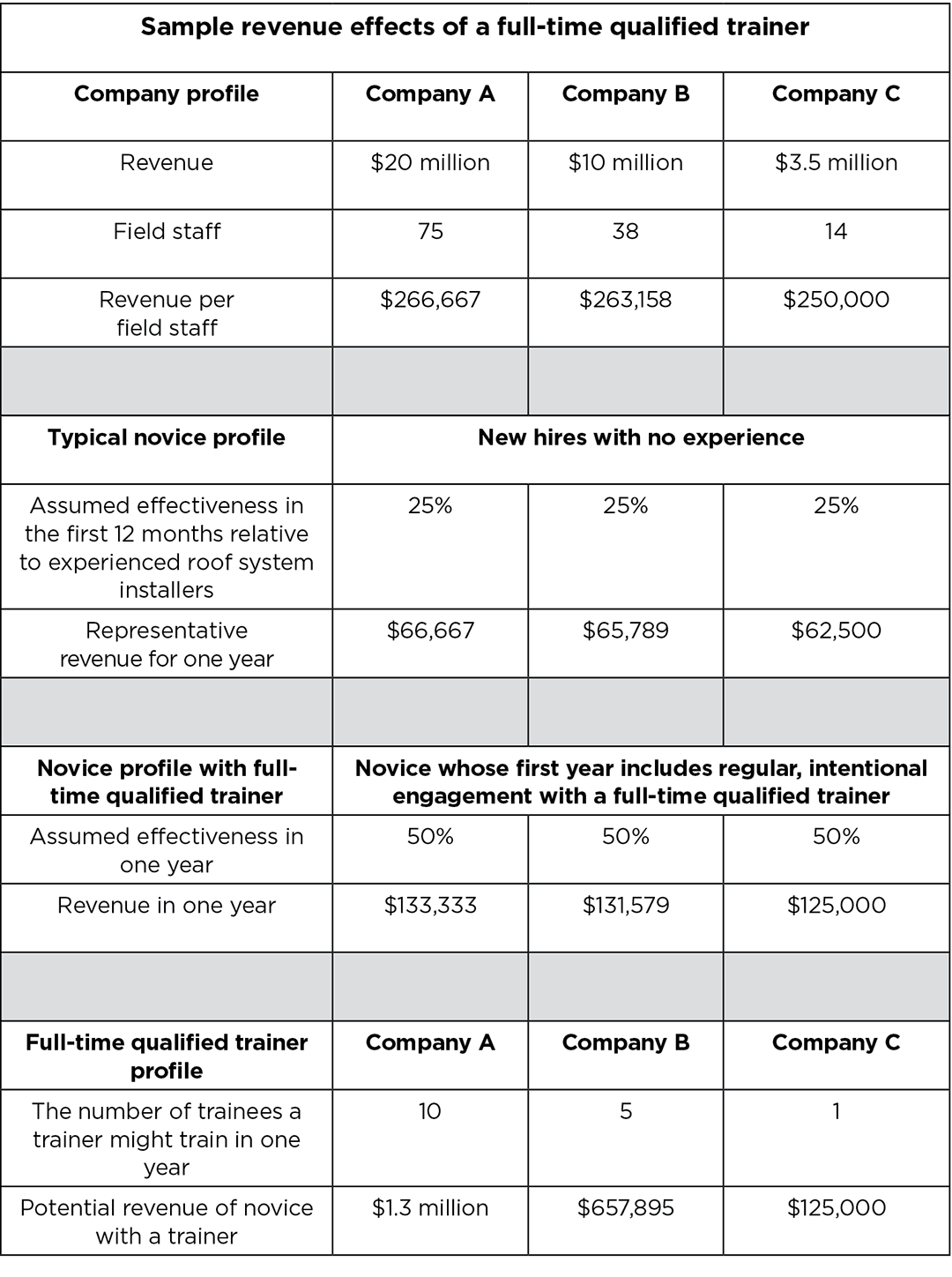
Many sectors of the U.S. are experiencing labor shortages, and it’s hitting especially hard in the roofing industry. More than 97% of respondents in the 2019 Roofing Alliance study “A Study of the U.S. Roofing Industry and Its Workforce” agree there is a shortage of skilled labor. And this shortage is forcing contractors to turn down work (69%) and manage increased costs (63%).
Other effects of the labor shortage respondents identify include the following, listed in order of frequency:
Project delays and overruns
Increased employee turnover rates
Slowdown in business growth
Strain on current skilled workers
Reduced quality of workmanship
Additional expenditures for advertising
Reduced customer satisfaction
Increased accidents and injuries
Although sobering, this data shows there is plenty of room for improvement, and finding ways to attract and retain workers can help the industry—and your company—continue to thrive.
Adding a full-time trainer
Maintaining a full-time trainer will help you retain new workers, and it is worthwhile to also examine the revenue potential. The figure on page 30 shows a sample analysis of the revenue effects of a full-time trainer for three companies of different sizes. You can create a similar chart and adjust the numbers for your company.
The Roofing Alliance study asked contractors and roofing employees how long it takes to train a new employee to the level of a general laborer. About 85% of each group said up to a year, and 15% said one to two years.
Josh Bersin, founder of Bersin by Deloitte, New York, studies human resources data across industries. In a 2013 LinkedIn article, “Employee Retention Now a Big Issue: Why the Tide has Turned,” Bersin asserts: “It may take a new employee one to two years to reach the productivity of an existing person, resulting in indirect costs to your organization.”
If you were to compare your new workers with your experienced employees, the new workers’ effectiveness likely is lower because they do not yet have the necessary skills to succeed. The sooner a new hire receives training and begins crafting his or her roofing skills, the sooner he or she will become an asset to your company.
The overall effect of training pays dividends far more impressive than a first-year revenue increase. Increased effectiveness in future years and a better chance novices will turn into long-term employees also are meaningful benefits.
Does it seem crazy to propose hiring a full-time trainer who might only train one person per year? Maybe. A small company might only have one new employee to train at any given time; the point is all new employees who receive dedicated training will benefit their companies more than those who do not.
Training even one novice in a year may increase your company’s revenue enough to cover all or most of a trainer’s salary and benefits.

Indirect benefits
There are additional benefits of training, especially for employee retention.
Gerardo Rodriguez is a full-time trainer with Nations Roof of Illinois, Villa Park. His company invested in developing him as a trainer when he was serving as the company’s warehouse manager. After his training, Rodriguez was promoted to a full-time trainer.
“We have seen our workers get better and show more pride in their work since Rodriguez has been up and running,” says Doug Duncan, president of Nations Roof of Illinois. “We see better quality installations with fewer issues along the way.”
Rodriguez recognizes the positive effects his role has on his team members.
“The training we provide is helping employees build a career in the roofing industry,” he says. “NRCA ProCertification® and Training for Roof Application Careers are helping our workforce prepare not just to work safely but also build careers in the roofing industry. Having a dedicated in-house trainer helps develop new employees’ potential and skills. In addition to the pros of the training new employees go through, it helps us know who shares our core values to help build a stronger team.”
Duncan and Rodriguez articulate benefits that have long-lasting repercussions for the company’s bottom line. Nations Roof of Illinois is developing employees who not only will help increase the company’s revenue capacities but also are working safely, aligning with company values and building careers with the company.
Losing employees costs companies dearly, above and beyond lost direct revenue. Bersin lists several costs that affect companies when employees leave. These costs include:
Recruitment: The costs of hiring new employees include job posting/advertising, interviewing, screening and hiring.
Onboarding: The cost of onboarding new employees includes not only training but also significant management time.
Lost productivity: It may take a new employee one to two years to reach the productivity of an existing worker.
Lost engagement and effect on employee morale: Other employees who see high turnover tend to disengage and lose focus on productivity, affecting team morale.
Customer service and errors: New employees take longer to complete their work and are less adept at solving problems.
When you add up these costs, it becomes clear a pattern of employee turnover wreaks havoc on companies’ bottom lines, and some of that havoc can be minimized with the addition of a dedicated trainer.
According to Geoff Mitchell, CEO of Mid-South Roof Systems, Forest Park, Ga., “We need to be able to put developmental steps in front of every employee who joins our team or industry. This is an unmistakable opportunity to retain great people and grow our industry. Part of being a great place to work is undoubtedly being able to help employees develop their skills and find what they enjoy doing. Having a person in charge of training and development allows us to focus on this.”
Mitchell echoes what many company leaders know: Showing new employees the company will help them develop skills is critical. And when a company cares about developing employees’ skills and helping them identify how their unique talents and interests can fit within the company, employees start realizing there is more for them than just a paycheck. Employees start treating their work as a career with a future and the company as their company.
NRCA can help
If you already have a full-time trainer or decide to hire one for your company, consider sending your trainer to an NRCA Qualified Trainer Conference. NRCA’s Qualified Trainer Conference is a two-day experience conducted virtually or in person that provides content and experiences to help participants develop classroom facilitation and hands-on coaching skills.
During the conference, participants learn the value of intentional, focused training and are provided with NRCA-developed hands-on training plans and skills to create their own plans. The overall goal is to empower trainers to advocate for intentional, regularly spaced training aimed at making new employees fully functional team members as soon as possible.
An NRCA Qualified Trainer is a beneficial addition to your team, but a trainer does not need to be an NRCA Qualified Trainer. Anyone conducting regular, intentional training should see similar benefits.
See for yourself
To help combat the workforce shortage challenge and increase your company’s revenue, consider adding a designated trainer to your team. Adjust the numbers in the figure to see the financial benefits for yourself.
When you factor in additional advantages such as overall employee satisfaction and retention, it becomes apparent a dedicated trainer is an important role for every roofing company.
AMY STASKA is vice president of NRCA University.



